We compare the two great Richmond premiership teams of 1980 and 2017
DUSTY or KB? Tony Jewell or Dimma? With Richmond fans in a state of footy nirvana, Glenn McFarlane looks at two dominant Tiger teams. Plus a statistical bonus for a champion centreman.
Richmond
Don't miss out on the headlines from Richmond. Followed categories will be added to My News.
IT’S the ultimate talking point for Richmond fans currently swept up in a state of football nirvana.
Which of the club’s past two premierships — a generation apart in time and half a world away in game style — was the most dominant?
SCROLL DOWN: GEOFF RAINES’ BIG DAY GETS BIGGER
Was it Richmond’s imposing, bruising blend of tall timber and sweeping runners in 1980, who monstered and menaced opponents? Or the 2017 Tigers’ version whose relentless pressure, connection and multi-pronged, small attack have swiftly become the template for modern football?
ONE-EYED REPORT: TIGERS’ BEST ‘IS THE BEST’
SALARY CAP: TIGERS’ HUGE IMBALANCE
And who had the better game of the Norm Smith Medal winners — the imperious Dustin Martin; or an evergreen Kevin Bartlett who kicked seven goals from half-forward in 1980?
In seeking an answer to those seemingly impossible questions, the Sunday Herald Sun engaged the services of the AFL’s official statisticians of the past 20 seasons, Champion Data, to take a forensic look of Richmond’s 81-point victory over Collingwood in the 1980 Grand Final through a modern statistical lens.
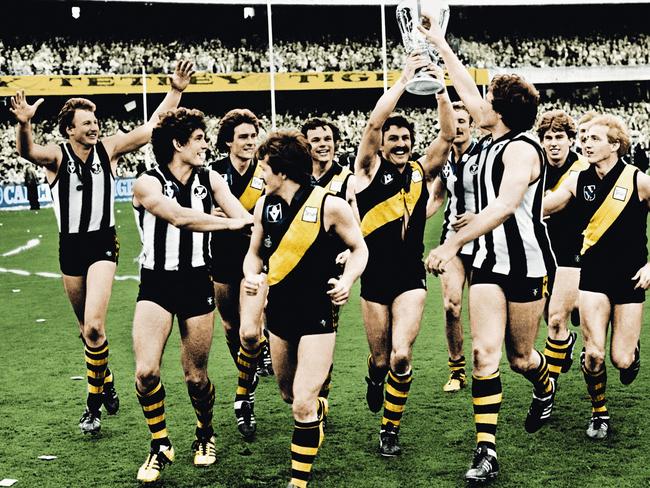
That includes each players’ SuperCoach rankings, pressure tallies, contested and uncontested disposals and marks, and metres gained figures.
Importantly, from a history point of view, that reassessment of statistics has added three extra disposals for star centreman Geoff Raines, determining he had 39 disposals — not 36, as he was credited with 38 years ago.
That has pushed Raines’ tally to an equal-record recorded in a Grand Final, joining Brisbane’s Simon Black on 39, which he collected in the 2003 Grand Final.
Champion Data’s AFL analyst Daniel Hoyne explained the re-evaluation wasn’t meant to downplay the way stats were recorded almost four decades ago, saying he had enormous admiration for those pioneers who crunched the numbers before the use of modern technology.
“The job they did back then was so hard,” Hoyne said. “We have 10 sets of eyes — 10 people — working every game. I would have thought it would have been three or four back in 1980.”
“We have access to watching it live at the ground with technology as opposed to doing it with pen and paper, but also the luxury of also reviewing play.”
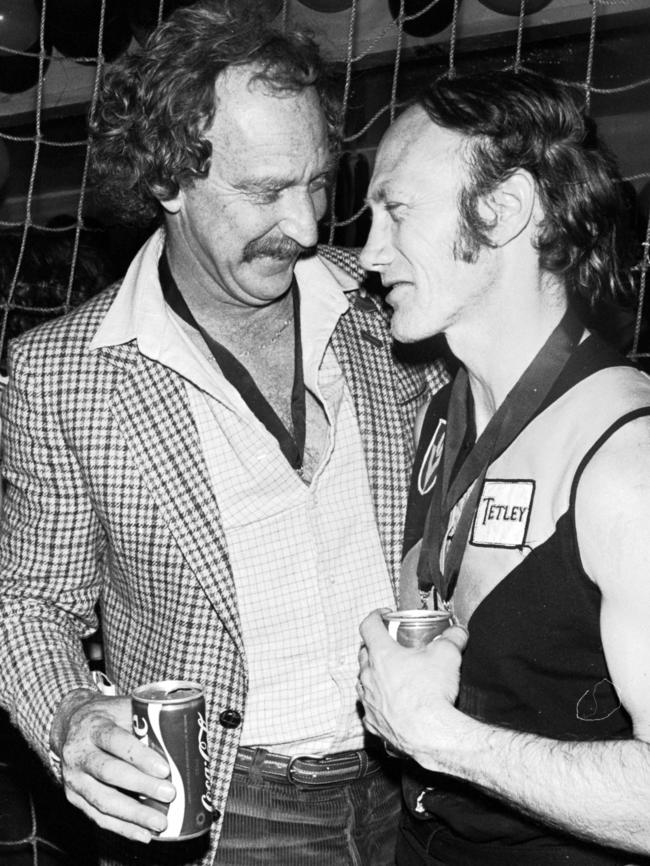
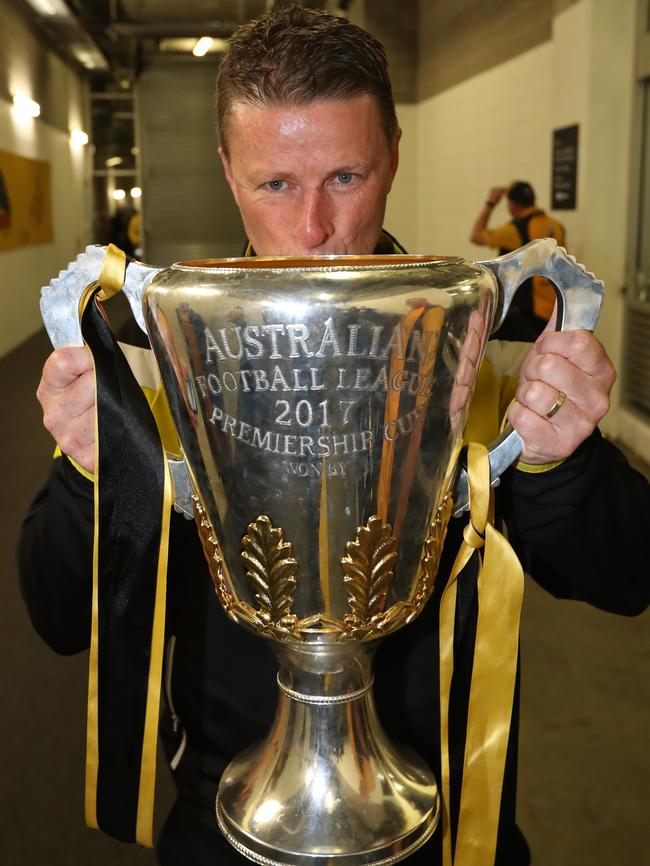
GAME STYLE
‘Jewell’s jewels’ v ‘Dimma’s dynamos’
It’s said footy trends don’t just change from year to year now, it happens almost on a weekly basis these days.
So you can imagine the difference that 38 years makes.
In make-up, these teams were markedly different. Richmond’s towering attack in 1980 included a combination of power forwards David Cloke and Michael Roach, while the “ageless, little champion” Bartlett, as Mike Sheahan called him at the time, provided the spark when the ball hit the ground.
The Tigers’ 2017 side had only one legitimate tall forward in Jack Riewoldt, with a swarm of small and mid-sized players providing the pressure and the spark.
In stats terms, the contrasts came in a few areas.
Tony Jewell’s team had 79 inside 50s that day in 1980 — for a scoreline of 23.21 (159) — which was 21 more than Damien Hardwick’s side managed for 16.12 (108) last September, and 27 more than the AFL average of 2017.
Part of the reason for the high number of inside 50s was that the pressure wasn’t as sustained as it is these days.
Predictably, the kick-to-handball ratio was significantly more back then than it was on Grand Final day in 2017.
“In some ways the two teams weren’t too dissimilar,” Hoyne said. “We saw (last Friday) the Tigers want to get the ball forward as quickly as they can. Their kick-to-handball ratio (against Hawthorn) was 1.78 … Richmond went at 1.93 in that (1980) Grand Final.”
Incredibly, the contested possession count for both the two sides in their Grand Final was almost identical — with the 1980 side having one extra, 171 to 170.
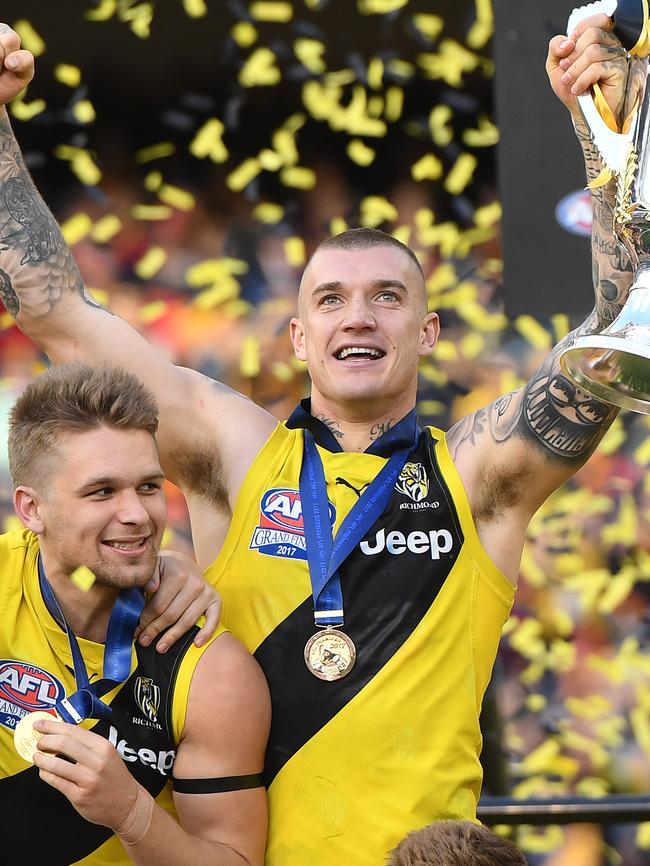

NORM SMITH WINNERS
Kevin Bartlett v Dustin Martin
Dustin Martin won virtually everything on offer in 2017.
But an assessment of his Grand Final performance when measured statistically against 33-year-old Bartlett’s 1980 masterclass sees him run second — ever so narrowly — in terms of SuperCoach rankings.
In Champion Data’s review of the 1980 Grand Final, their rankings were eerily almost identical. But Bartlett scored 151 SuperCoach points, while Martin had 150.
Yes, we know they played different roles.
Martin was essentially a midfielder who went forward at times to kick two goals in his 29-disposal game. Bartlett, a legendary rover in his prime, was a permanent forward by 1980, kicking his seven goals in the Grand Final from 21 disposals.
Only one of Bartlett’s disposals was a handball — surprise, surprise — while Martin had more handballs (15) than kicks (14) in last year’s Grand Final.
“I’m surprised that he had any,” Raines joked of his teammate. “It (his one handball) must have been a mistake.”
“Geez, he did it reluctantly. He said he didn’t need to handball, and he was probably right. We all shared the ball around, all of us, except KB.”
Bartlett won the only second Norm Smith Medal on offer, and while those judging it wouldn’t have known at the time, he had 591 metres compared to Martin’s 371.
But the 2017 Grand Final best-afield had the edge on Bartlett with almost three times as many contested possessions — an incredible 22 to 8.

CLASS IN THE CENTRE
Geoff Raines v Trent Cotchin
Raines was so exhausted after the 1980 Grand Final triumph he could barely get his way around the victory lap, and couldn’t relax with a beer and a meal until well after 10pm that night.
“I was knackered,” Raines told the Sunday Herald Sun this week. “I was that stuffed that I could hardly run the victory lap.”
He had been a Norm Smith contender along with ruckman Mark Lee and Bartlett, and Champion Data’s revised statistics show precisely why (scroll to bottom to read).
An analysis of Raines’ game showed he not only had 39 disposals (including a huge 19 handballs for the era), his capacity for breaking away with the ball and then roosting it 60 metres or more meant he has been credited with an incredible 883 metres gained.
He had 143 SuperCoach points with 11 score involvements.
Trent Cotchin, who played a selfless role in the 2017 flag, had almost 300 metres gained, with his pressure points being an indication of his influence on the team.
The thing Raines is most proud of to this day is how Champion Data’s analysis showed 21 of his 39 disposals were contested.
“I might have to give TJ (Jewell) a call to let him know,” he joked. “He was all over the educated blokes in the team and wanted us to play like the electricians and the tradies. He would have been pleased with that contested possessions count.”
But Raines was keen to point out just how team-orientated Cotchin had been in Richmond’s breakthrough 2017 premiership win. “He was so important,” he said.
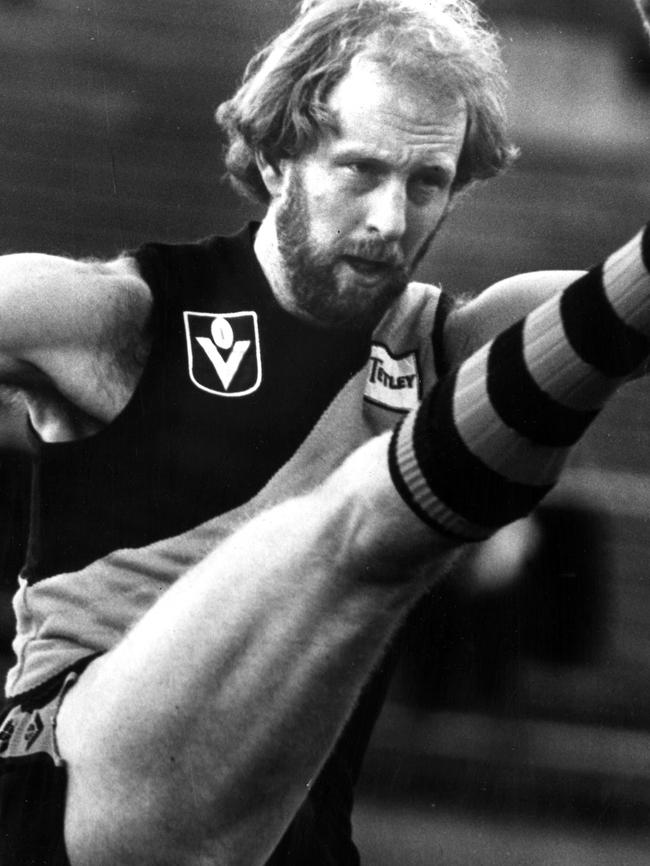

BACKS TO THE FUTURE
Jim Jess v Alex Rance
The importance of Richmond’s defence in 1980 and 2017 should never be underestimated, with the examples of Jim Jess and Alex Rance testament to this.
Jess was a key player in the game 38 years ago, with his 15 disposals yielding a surprising 423 metres gained.
“Jimmy would kick them 60 or 70 metres every time,” Raines said of his teammate’s long-kicking game that so often turning defence into attack.
That would have accounted for his high number of metres gained, though his pressure levels and intercept qualities were different to Rance’s 2017 game. He had four intercept possessions, but only one intercept mark.
Jess, who had 77 SuperCoach points, wasn’t registered with a one-on-one contest, while Rance won six of his 11 one-on-one contests.
Considered one of the greatest defenders of any era, Rance may have had four fewer disposals than the man they called ‘the Ghost’, and only 189 metres gained, but his 103 SuperCoach ranking showed his importance in the back half against the Crows last year.
Ten of Rance’s 11 possessions were intercept possessions — a huge effort — and he had five intercept marks, from which the Tigers derived so much benefit.

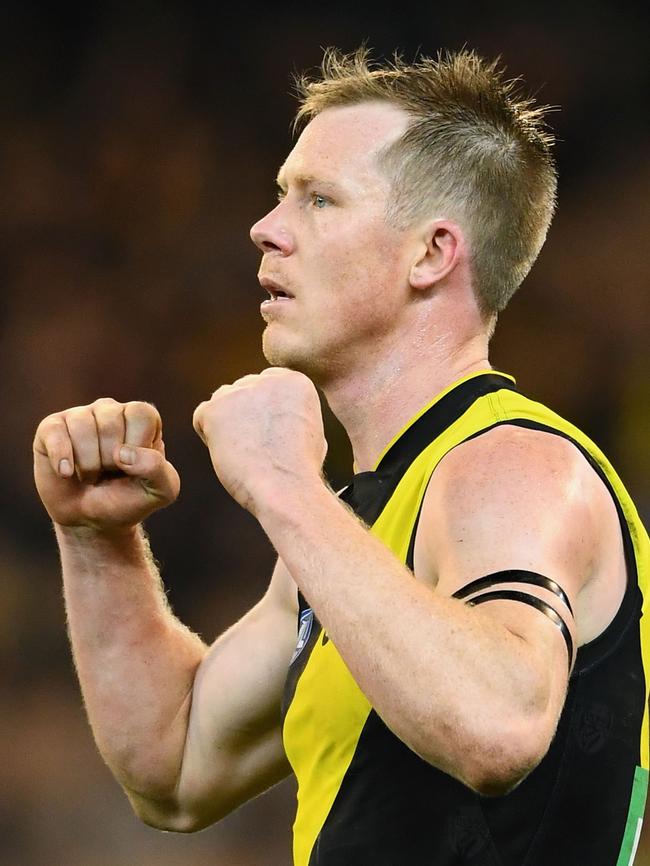
THE FORWARD BATTLE
David Cloke v Jack Riewoldt
Only David Cloke and a friendly local doctor knew how close the Tigers’ 1980 vice-captain came to missing out on that year’s Grand Final.
Suffering from plantar fascia — a painful inflammation of the heel which was still a bit of mystery back then — Cloke was told by Jewell he had prove his fitness by training in every session leading up to the Grand Final.
That was complicated by the fact the club doctor wouldn’t give him painkilling injections until game day.
“TJ said I could play, but the only stipulation was that I had to train all week,” Cloke recalled.
“I trained on the Monday night and was sore. I rang the club doctor, but he wouldn’t inject it. So I went to a mate of mine and he said he would do it. It helped me get through the week and I was named in the forward pocket.”
On game day, Cloke was injected before the match and again at halftime, which paid dividends with the Tiger forward kicking six goals, one fewer than Bartlett.
But he recalls it should have been more: “I had 11 shots, you don’t have to remind me … it was 6.4 and one out on the full.”
Cloke’s six goals, nine marks and eight marks inside 50 contributed to his 124 SuperCoach points.
The Tigers had eight individual goalkickers in 1980 — Michael Roach, who kicked 107 for the season only managed two for the game — while Richmond’s 2017 side had 11 individual players who scored goals, with only fifth-gamer Jack Graham kicking three goals.
Jack Riewoldt kicked two goals. But it was his pressure rating that stood out when comparing him to Cloke.
While Cloke was accredited with 10 forward-half pressure points in 1980, Riewoldt had an impressive 37 in last year’s Grand Final. That helped the 2017 leadership group member push his SuperCoach ranking to 110, a performance which earned him plenty of credits, and a post-game cameo with The Killers.
Cloke, in contrast, with his foot still aching, didn’t miss the celebrations but was in hospital being operated on by the start of the next week.
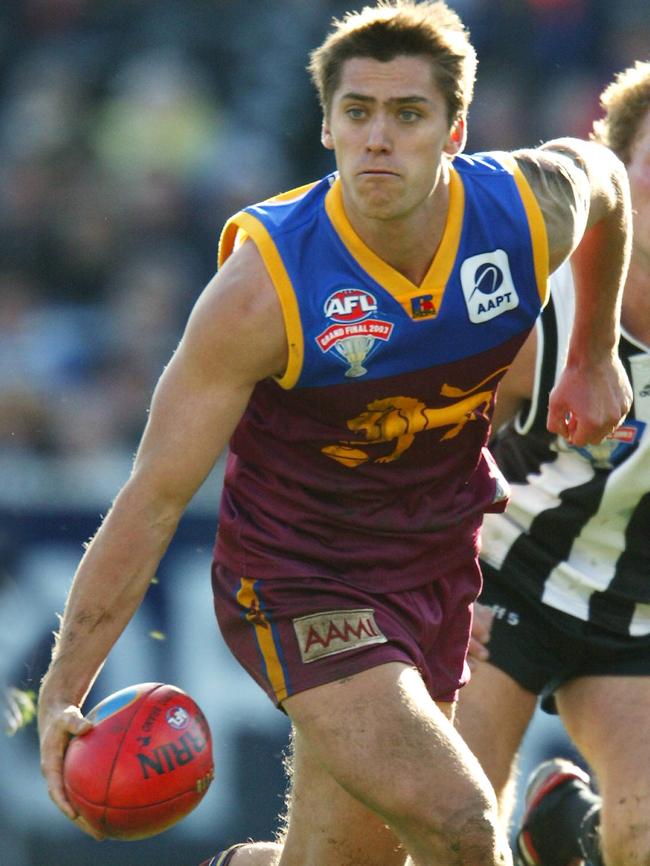
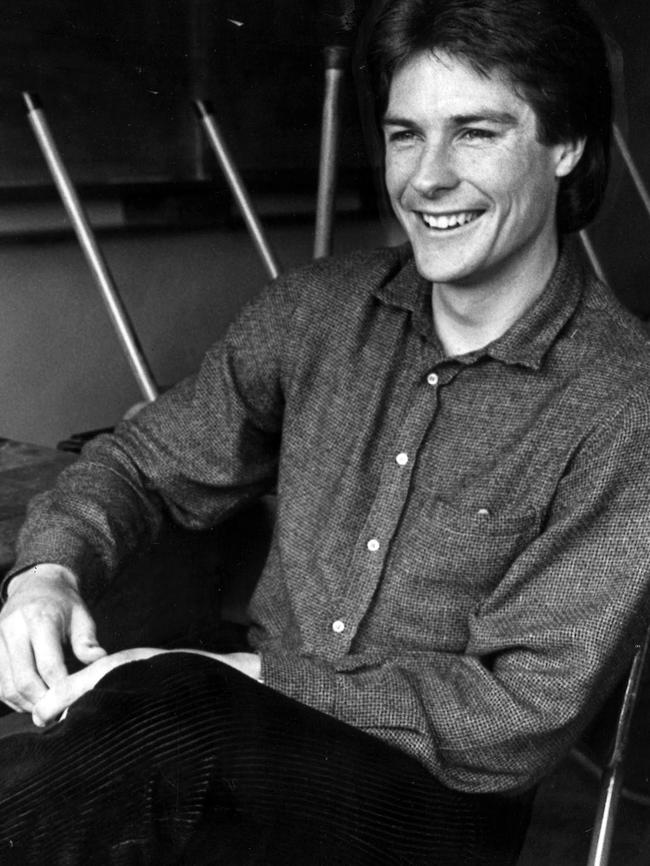
RAINES EQUALS SIMON BLACK
A STATISTICAL re-examination of the 1980 Grand Final has revealed star centreman Geoff Raines had 39 disposals in Richmond’s 81-point win over Collingwood, equalling the record for a premiership playoff recorded by Brisbane Lions Simon Black in 2003.
Raines was credited with 36 possessions for the game at the time.
But the Sunday Herald Sun’s decision to engage Champion Data, the AFL’s chief statistician of the past 20 seasons, to review the Tigers’ premiership 38 years ago showed that Raines should have been credited with another three disposals.
Raines, now 62, and a player who should be in consideration for Australian Football Hall of Fame honours, could barely believethe news.
“I know I had quite a few touches, but I wouldn’t have known how many,” Raines said.
“Usually with ex-players the stories get larger and larger over time, but I am pleased you are backing this up with facts. This story keeps getting better and better.
“If I have equalled Simon Black, I think that’s fabulous news.”
When contacted this week with the revelation Raines’ revised 1980 tally had equalled Black’s 39, the AFL said it was an “interestingdiscussion topic”, but said it would not change the record books.
“It’s not something we’d be likely to go and formally rule upon, as disposals in a Grand Final has never been a focus for the game’s records,” an AFL spokesman said.
“Those records the game has deemed critical are centred around the winners, goalkickers, best players and the Norm Smith Medallist.”


